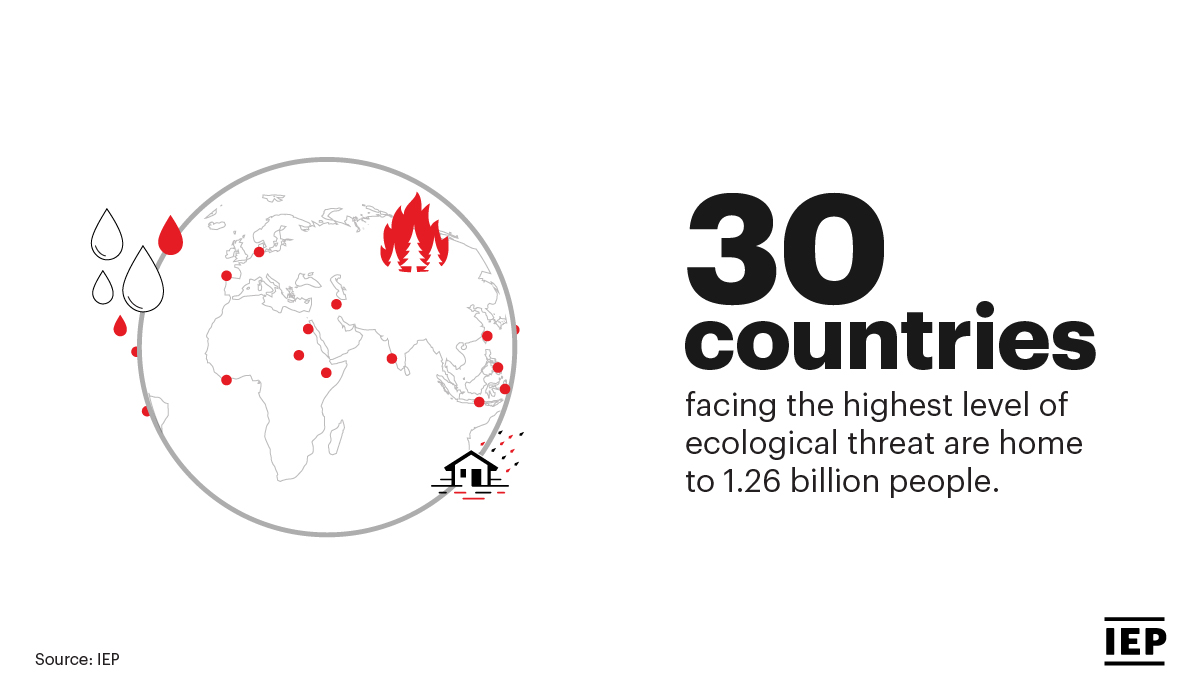Healthy wildlife and ecosystems ensure protection from environmentally-related conflict. For instance, soil depletion and natural resource scarcity, and their resulting impact on food and income, can quickly foster socio-economic conflict. Unhealthy wildlife populations and ecosystems, especially coupled with violence or poverty, can create high-conflict events like mass migration. The effects in one direction, for instance the recent socioeconomic conflict on nature, are already understood to be detrimental. Wildlife is killed directly, ecosystems are devastated by warfare and rapid modification, and there is severely reduced capacity for conservation initiatives. Conversely, effective and sustainable implementation of conservation initiatives can effectively contribute to the mitigation of socioeconomic and armed conflict.
IEP’s Ecological Threat Register (ETR) demonstrates the importance of environmental conservation in peacebuilding efforts. The ETR outlines that by 2040, 5.4 billion people will experience high or extreme water stress. Furthermore, 30 countries comprising over 1 billion people have been identified as lacking the social and economic resilience to withstand the impact of ecological events which are becoming increasingly frequent globally. The consequence of this is mass population displacement, food insecurity, civil unrest and competition over resources.

It is important to note that certain conservation practices themselves can be catalysts for conflict as well. Historically, non-equitable conservation and colonial, protectionist strategies have contributed to or exacerbated conflict.
So, with conservation and socio-economic conflict being so inextricably linked, how can we use interdisciplinary frameworks to mitigate and manage the two?
IEP’s Ambassador program introduces the Positive Peace Framework to participants. This analytical structure attempts to empirically provide a context for approaching complex global challenges, and asks: How can we better understand how to create and maintain peaceful societies? Where do environmental action and conservation fall into this?
This framework includes 8 Pillars of Positive Peace that provide analytics tools that identify the optimal environment for human potential to flourish. They include a Well-functioning Government, Sound Business Environment, Equitable Distribution of Resources, Acceptance of the Rights of Others, Good Relations with Neighbours, Free Flow of Information, High Levels of Human Capital, and Low Levels of Corruption.
My analysis examined these elements in the context of wildlife conservation: how are they already being implemented? How can we use this to create sustainable mitigation and management techniques? All eight of these pillars of Positive Peace were easily applied to wildlife conservation work and are an example of how we can use multi-disciplinary techniques to approach conservation in the future.
One example identified in my analysis is the Rights of Nature Doctrine, which outlines not only the rights of flora and fauna as a vital part of our ecosystem but how these interrelate with human rights. This is a direct example of the Acceptance of the Rights of Others pillar, wherein a society must accept the rights of those within it in order to achieve peacefulness.
A further example of Positive Peace being successfully implemented in conservation is in the global undertaking of protected areas and peace parks that work to prioritize conservation and peace across geopolitical boundaries: fostering international cooperation and the well-being of people and the planet. In the Kavango Zambezi Transfrontier Conservation Area (KAZA), this demonstration of the Good Relations with Neighbors pillar has resulted in the protection of more than a quarter of a million animals and over 3,000 different plant species across five countries.

As we can see in these examples, Positive Peace is inadvertently being applied successfully in the conservation field, but through a more focused approach surrounding the 8 pillars of Positive Peace, conservation efforts might prove more effective and long-lasting.
Initiatives within this field have oftentimes been siloed in both perspective and methodology; but with conflict and conservation so clearly interlinked, we can combine the social and biological sciences to create solutions that work for both people and the planet.
IEP Ambassador Program
Throughout the IEP Ambassador Program, participants engage in a series of webinars where they are introduced to IEP’s Positive Peace Framework. The Positive Peace Framework involves using a systems-based approach to better understand the creation and maintenance of peaceful societies.
IEP’s empirically based research teaches us that the health of a society must be understood within the broader context of its attitudes, institutions and structures. Where these are positive, they will contribute to creating a state of Positive Peace. This is as opposed to the common practice of viewing peace as being measured only by the absence of violence, also known as Negative Peace.